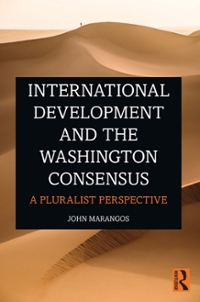Question
The article below, written in 2021, describes the impact of the Covid-19 pandemic and drought on the supply of tea in India. Read the extract
The article below, written in 2021, describes the impact of the Covid-19 pandemic and drought on the supply of tea in India. Read the extract below, t
Covid threat and drought combine to put India's tea harvest at ris
India's tea harvest is at risk as Covid-19 infections spread across plantations already struggling with a torrid drought.
At least 90 tea gardens in Assam, India's top tea-producing state, have reported cases andwith manydeclared containment zones, according to thelocal teaassociation,as authorities try to stop the virus spreading into more of the state's 800 plantations.
About 500 cases have been confirmed but planters said more testing was needed to detect the true magnitude of the outbreak.
India is the world's second-largest tea producer after China, and competes with countries such as Kenya and Sri Lanka in the export market.
Producers warn that, if not brought under control, the outbreaks could ruin the harvest season and push prices higher.
"Last year, the tea gardens were miraculously spared," said Prabhat Bezboruah, chair of the Tea Board of India. "This time... the portents are ominous."
The outbreaks on tea plantations highlight the reach of India's second wave that has left no corner of the country untouched. Coronavirus has spread into remote areas after taking a devastating human toll in the cities and disrupting industry and economic activity.
India on Sunday reported more than 310,000 new Covid-19 cases and more than 4,100 deaths on the previous day.Experts believe the figures are vast undercounts.
Assam and neighbouring West Bengal, home to famed tea-producing hub Darjeeling, are each reporting their own surges. Both states recently held local elections that public health experts said fuelled infection.
Labour groups blame what they call the cramped working conditions on tea plantations for the surge in cases.
Living quarters "are densely populated. The workers work or move in large groups, so the chance of rapid increase in the number of infections among them is very alarming," Dhiraj Gowala, president of the Assam Tea Tribes Students Association, wrote in a letter to the local government.
India's tea industry is already weakened by everything from erratic weather patterns linked to climate change to last year's lockdown, which brought the harvest to a halt for several weeks.
That lost output helped push Indian prices to record highs last year, giving Kenya and Sri Lanka an advantage in the export market.
Ibi Idoniboye, an analyst at commodities data firm Mintec, said the latest disruption on Indian plantations could create another opening for producers such as Sri Lanka to sell more to large consumers such as Russia.
Producers worry they face another lost year. The threat of coronavirus is exacerbated by a severe drought in Assam and India's north-east, which has left tea leaves withering on their bushes.
"You put your hand into the soil and you just pick up dust. Normally it's lumpy and muddy by this time," said Nazrana Ahmed, who runs a plantation near the city of Dibrugarh in Assam.
North Indian tea production of 47m kg in March was higher than last year, according to tea trader Van Rees, but still well short of the 60m kg harvested in March 2019, the last 'normal' year.
Tea auction prices in Kolkata, the main export hub, jumped more than 40 per cent to Rs287.5 per kg in April from the previous month, according to Mintec.
Vivek Goenka, president of the Indian Tea Association, said authorities were setting up vaccination camps to inoculate plantation workers but were struggling to procure shots amid a severe nationwide shortage of jabs.
"Hopefully we'll be able to contain the situation," he said. "I'm not saying it'll disappear overnight... It really depends on how swiftly and promptly we can control this."
Source: Parkin and Terazono (2021)
Note: The unit 'm kg' referred to in this article means millions kg.
- Parkin and Terazono (2021) describe some of the effects of the Covid pandemic and climate change on the production of tea in India. Assuming that the market for tea in India is perfectly competitive, use a demand and supply diagram to explain how the Covid pandemic and climate change in India have changed the market equilibrium price and quantity of tea in India in 2020 and 2021 in comparison with the last 'normal' year 2019.
- Briefly describetwo limitationsof the perfectly competitive model of markets in modelling the changes in equilibrium prices and quantities in the Indian market for tea.
Step by Step Solution
There are 3 Steps involved in it
Step: 1

Get Instant Access to Expert-Tailored Solutions
See step-by-step solutions with expert insights and AI powered tools for academic success
Step: 2

Step: 3

Ace Your Homework with AI
Get the answers you need in no time with our AI-driven, step-by-step assistance
Get Started


